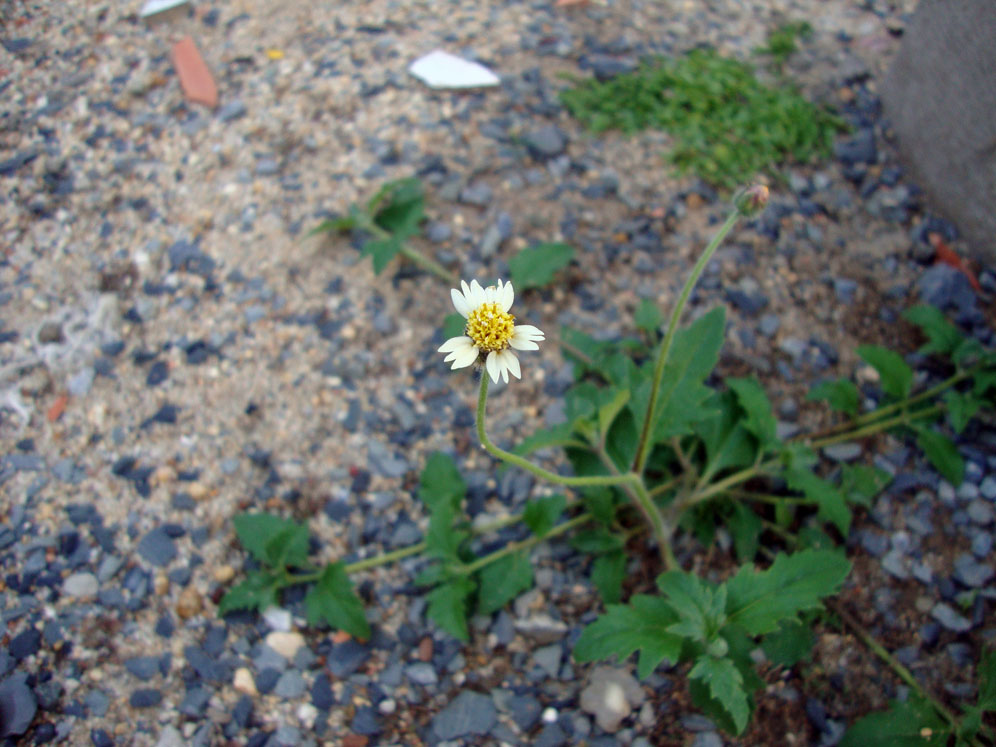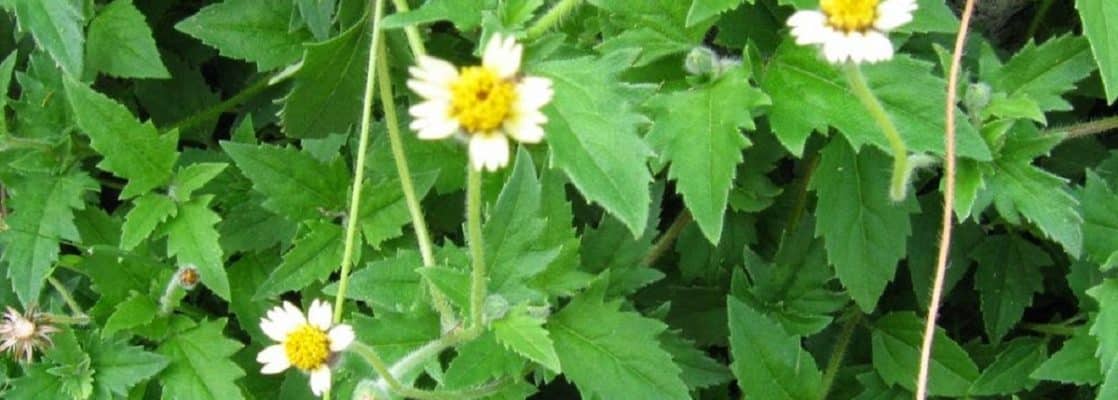Coat Button Plant (Tridax procumbens)

Coat Button Plant (Tridax procumbens) is a flowering plant in the family Asteraceae. It is native to the tropical Americas but has been introduced to many other regions of the world. It is also known as coat buttons, tridax daisy, cadillo chisaca, and herbe caille
The plant has white or yellow flowers, with three-toothed ray florets and yellow centres. The leaves are arrowhead-shaped and toothed. The fruit is a hard achene with stiff hairs and a white pappus. The plant can produce up to 1500 seeds per plant and can spread by wind, water, animals, and human activities
However, the plant also has some medicinal and nutritional uses. Traditional medicine has used it to treat wounds, ulcers, inflammation, infections, and diabetes. It has antibacterial, anti-inflammatory, antioxidant, and antidiabetic properties. It also contains phytochemicals such as spilanthol, flavonoids, tannins, phytosterols, and saponins
The plant is also used as a forage crop for livestock, as it is nutritious and palatable. It can also be used as a turf grass for lawns, golf courses, and sports fields, as it is drought-tolerant and can tolerate heavy traffic. It can also be used for erosion control, soil stabilization, and ornamental purposes
The Health Benefits of Coat Button
The plant has many health benefits, according to the web search results. Some of the reported benefits are:
- It can treat skin diseases and heal wounds, as it has antibacterial, antifungal, and antiseptic properties. It can also stop bleeding and reduce inflammation. The juice or paste of the leaves and flowers can be applied directly to the affected areas
- It can help with diabetes, as it has antidiabetic and hypoglycemic effects. It can lower blood sugar and cholesterol levels, and increase insulin secretion and sensitivity. The tea or tincture of the leaves and flowers can be taken orally to regulate blood glucose
- It can prevent and treat infections, such as colds, flu, malaria, and vaginitis. It has antiviral, anti-inflammatory, and immunomodulatory effects. It can also relieve fever, cough, and sore throat. The tea or tincture of the leaves and flowers can be taken orally or gargled to fight off germs
- It can improve liver and digestive health, as it has hepatoprotective and gastric properties. It can protect the liver from damage and toxins, and treat jaundice, gastritis, and heartburn. It can also prevent and cure diarrhoea and dysentery. The tea or tincture of the leaves and flowers can be taken orally to enhance liver and digestive functions
- It can promote hair growth and prevent hair loss, as it has a hair tonic effect. It can nourish the scalp and hair follicles, and prevent dandruff and fungal infections. The oil or juice of the plant can be massaged into the scalp and hair to stimulate hair growth and prevent hair fall

How to use Coat Button Plant for Medicinal Purposes:
- Skin diseases and wounds: You can use the juice or paste of the leaves and flowers of Coat Button Plant to treat skin diseases and wounds, such as cuts, burns, boils, eczema, and fungal infections. The plant has antibacterial, antifungal, and antiseptic properties that can prevent infection and speed up healing. It can also stop bleeding and reduce inflammation and pain. To use the plant, wash the affected area with clean water and apply the juice or paste directly on the skin. Cover it with a bandage or cloth and change it every day.
- Diabetes: You can use the tea or tincture of the leaves and flowers of Coat Button Plant to help with diabetes, as it has antidiabetic and hypoglycemic effects. The plant can lower blood sugar and cholesterol levels, and increase insulin secretion and sensitivity. It can also prevent and treat diabetic complications, such as neuropathy, nephropathy, and retinopathy. To use the plant, boil one cup of water and add one teaspoon of dried or fresh leaves and flowers. Steep for 10 minutes and strain. Drink the tea two to three times a day before meals. Alternatively, you can take 10 to 20 drops of the tincture three times a day.
- Infections: You can use the tea or tincture of the leaves and flowers of Coat Button Plant to prevent and treat infections, such as colds, flu, malaria, and vaginitis. The plant has antiviral, anti-inflammatory, and immunomodulatory effects that can fight off germs and boost the immune system. It can also relieve fever, cough, and sore throat. To use the plant, boil one cup of water and add one teaspoon of dried or fresh leaves and flowers. Steep for 10 minutes and strain. Drink the tea two to three times a day. Alternatively, you can take 10 to 20 drops of the tincture three times a day. You can also gargle with the tea or tincture to treat oral infections.
- Liver and digestive health: You can use the tea or tincture of the leaves and flowers of the Coat Button Plant to improve liver and digestive health, as it has hepatoprotective and gastric properties. The plant can protect the liver from damage and toxins, and treat jaundice, hepatitis, and cirrhosis. It can also treat gastritis, heartburn, ulcers, and indigestion. It can also prevent and cure diarrhoea and dysentery. To use the plant, boil one cup of water and add one teaspoon of dried or fresh leaves and flowers. Steep for 10 minutes and strain. Drink the tea two to three times a day. Alternatively, you can take 10 to 20 drops of the tincture three times a day.
- Hair growth and hair loss: You can use the oil or juice of the plant to promote hair growth and prevent hair loss, as it has a hair tonic effect. The plant can nourish the scalp and hair follicles, and prevent dandruff and fungal infections. It can also stimulate blood circulation and hair growth, and prevent hair fall and baldness. To use the plant, extract the oil or juice from the fresh leaves and flowers. Massage the oil or juice into the scalp and hair for 10 to 15 minutes. Leave it for another 15 minutes and then wash it off with a mild shampoo. Repeat this two to three times a week.
Some of the possible side effects of Coat Button Plant:
- It may cause allergic reactions in some people, such as skin rash, itching, swelling, or difficulty breathing. If you have any of these symptoms, stop using Coat Button Plant and seek medical attention
- It may interact with some medications, such as lithium, which is used to treat bipolar disorder. Coat Button Plant may have a diuretic effect, which means it can make the body lose water and increase the amount of lithium in the blood. This can lead to serious side effects, such as nausea, vomiting, tremors, confusion, or seizures. If you are taking lithium, consult your doctor before using Coat Button Plant
- It may lower blood pressure, which can be beneficial for people with hypertension, but it can also cause problems for people with low blood pressure or heart conditions. Coat Button Plant may act as a vasodilator, which means it can widen the blood vessels and improve blood flow. However, this can also lower blood pressure too much and cause dizziness, fainting, or irregular heartbeat. If you have low blood pressure or heart problems, be careful when using Coat Button Plant

